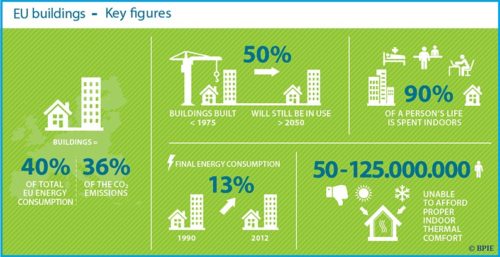
Photo: BPIE
The main author: Frances Bean, Buildings Performance Institute Europe (BPIE). Co-author: Mariangiola Fabbri (BPIE)
On 9th July 2018, the new revised Energy Performance of Buildings Directive (EPBD) entered into force. This revision strengthened action to propel the EU towards a highly efficient and decarbonized building stock. It will enable citizens, owners and tenants to live in better buildings, in terms of energy performance, comfort and well-being.
EPBD developments
After over a year of intense negotiations since the proposal was launched by the European Commission in 2016, the European Parliament and Council came to an agreement.
The directive maintains some of the earlier EPBD elements (such as requirements to introduce nearly Zero Energy Buildings (nZEB) by 2020, cost-optimality as the guiding principle to define energy performance standards, and Energy Performance Certificates (EPCs) to provide information to owners and tenants) and introduces a few novelties: a new article requiring Member States to deliver long-term renovation strategies with the aim to reach a highly efficient and fully decarbonised building stock by 2050; provisions linking financing to renovation; e-mobility requirements to prepare buildings for the electrification of private transport by providing EV-charging points; a new voluntary smartness indicator to help manage and reduce the demand of energy in buildings and a requirement for the European Commission to perform a feasibility study by 2020 assessing the introduction of the building renovation passport as a complement to Energy Performance Certificates (EPCs).
By maintaining some of the key elements of the EPBD, Member States will continue the implementation of the directive without major disruption and integrate the new elements during the transposition period – all Member States must transpose the directive into national legislation by March 10 2020.
Putting buildings at the center of Europe’s energy transition
One of the most critical elements introduced by the new EPBD is a more focused approach on renovation. Considering that 97% of the existing building stock needs to be upgraded, the only way to achieve the 2050 vision is to renovate most of our building stock.

Triggering renovation requires striking a balance between promoting tools to stimulate the renovation market and defining mandatory requirements for better performing buildings. National long-term renovation strategies create an opportunity for Member States to introduce new policies and measures to support the renovation of the national building stock. This will facilitate the cost-effective transformation of existing buildings into nearly-zero energy buildings and the achievement of the 2050 vision of a highly energy efficient and decarbonised building stock.
The directive lists a series of measures to incorporate in the strategies, including actions to stimulate deep renovation, the identification of trigger points, policies and actions to target the worst performing segments of the building stock and an outline of actions to contribute to the alleviation of energy poverty. Member States can decide on the measures to adopt in their strategies and provide indicative milestones for 2030 and 2040 and measurable indicators (e.g. renovation rates or a cap on energy consumption per square meter) to track and measure progress. The strategies must also address issues such as health, well-being and air quality.
This should generate new momentum for the renovation of our buildings. The role of buildings in the transition to a sustainable and secure energy system is indisputable and the Energy Performance of Buildings Directive contributes to putting buildings at the centre of Europe’s energy transition.
Vrbas, Lajkovac, and Sopot inspiration for other municipalities and input for national renovation strategy
The changes in the EPBD will also influence how accession countries will deal with renovation in the future as, in time, they will have to adopt the same objectives as the EU Member States. Given the state of the current building stock in these countries, renovation is a major challenge for them, as it is for most EU Member States. In many accession countries, the development of renovation strategies is underway as part of the commitment under the Energy Community Treaty. Nevertheless, these countries could step up their efforts to upgrade the building stock.
Local authorities in many countries are taking the lead. The EmBuild project supported local authorities and yielded some interesting examples which can inspire and support national and local governments to renovate their buildings. For example, the project supported municipalities in Serbia to develop renovation strategies. Three model strategies were developed for the municipalities of Vrbas, Lajkovac, and Sopot. These can be used as basis for strategies in other municipalities, and can inspire and provide input for the national renovation strategy.
The revised EPBD requires Member States to consult publicly on the renovation strategy before it is published, and to continue inclusive consultation during implementation. This will be an important opportunity for greater collaboration and involvement of local municipalities in the development of national strategies.


















Be the first one to comment on this article.